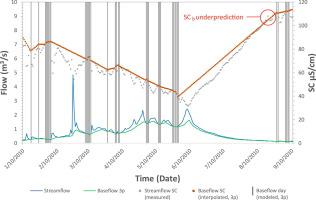当前位置:
X-MOL 学术
›
J. Hydrol.
›
论文详情
Our official English website, www.x-mol.net, welcomes your
feedback! (Note: you will need to create a separate account there.)
Hydrograph separation through multi objective optimization: Revealing the importance of a temporally and spatially constrained baseflow solute source
Journal of Hydrology ( IF 5.9 ) Pub Date : 2020-11-01 , DOI: 10.1016/j.jhydrol.2020.125349 Benjamin Hagedorn
Journal of Hydrology ( IF 5.9 ) Pub Date : 2020-11-01 , DOI: 10.1016/j.jhydrol.2020.125349 Benjamin Hagedorn

|
Abstract Quantifying baseflow is key to a reliable understanding of water quality, supply and habitat. This is especially valid for watersheds in California, USA, where changing precipitation, evapotranspiration and snowmelt patterns coupled with a land use/land cover transition towards urban/agricultural dominance imply drastic impacts on baseflow. This study presents a new approach to stream hydrograph separation using multi objective optimization. Applying the Mixed Integer Distributed Ant Colony Optimization (MIDACO) solver, baseflow is modeled at two stream sites in California by linking daily baseflow and surface runoff simulations from a recursive digital filter (RDF) with those obtained from chemical, i.e., specific conductance (SC), mass balance. Objective functions are based on (1) a modified Nash Sutcliffe Efficiency (mNSE) index that gages how well the model can reproduce measured stream SC, and (2) a mass balance indicator that limits the occurrences of stream SC exceeding the modeled baselow SC end member. This baseflow SC end member is derived from interpolation of stream SC on consecutive baseflow days predicted by the RDF in the optimization. The associated RDF parameter k, RDF pass number (1–5) and surface runoff SC end member are set as adjustable parameters determined via calibration. Optimum (i.e., trade off) solutions indicate good to very good model performance in terms of mNSE statistics despite the competing nature of applied objective functions. Results furthermore indicate a high sensitivity towards (1) site location, with best results for the more remote “upstream” site, and (2) RDF pass number, with best results obtained by the 2 and 3 pass applications. Significant correlations between baseflow and baseflow SC and annual drought indices reveal an immediate response of the system to precipitation deficit that should be considered carefully in future water resource projections.
中文翻译:

通过多目标优化进行水位线分离:揭示时空约束基流溶质源的重要性
摘要 量化基流是可靠了解水质、供应和栖息地的关键。这对于美国加利福尼亚州的流域尤其有效,其中降水、蒸散和融雪模式的变化以及土地利用/土地覆盖向城市/农业主导地位的转变意味着对基流的巨大影响。本研究提出了一种使用多目标优化进行河流水位图分离的新方法。应用混合整数分布式蚁群优化 (MIDACO) 求解器,通过将来自递归数字滤波器 (RDF) 的每日基流和地表径流模拟与从化学物质(即比电导率 (SC) ), 质量平衡。目标函数基于 (1) 修改后的纳什萨特克利夫效率 (mNSE) 指数,该指数衡量模型重现测量流 SC 的能力,以及 (2) 质量平衡指标,用于限制流 SC 超过建模的基低 SC 端的发生成员。该基流 SC 端成员来自于优化中 RDF 预测的连续基流天数的 SC 插值。相关的 RDF 参数 k、RDF 通道数 (1-5) 和地表径流 SC 端构件设置为通过校准确定的可调参数。尽管应用的目标函数具有竞争性,但最佳(即权衡)解决方案在 mNSE 统计方面表明模型性能良好到非常好。结果进一步表明对(1)站点位置的高度敏感性,对于更偏远的“上游”站点具有最佳结果,(2) RDF pass 数,通过 2 和 3 pass 应用获得最佳结果。基流和基流 SC 与年度干旱指数之间的显着相关性揭示了系统对降水不足的直接响应,在未来的水资源预测中应仔细考虑这一点。
更新日期:2020-11-01
中文翻译:

通过多目标优化进行水位线分离:揭示时空约束基流溶质源的重要性
摘要 量化基流是可靠了解水质、供应和栖息地的关键。这对于美国加利福尼亚州的流域尤其有效,其中降水、蒸散和融雪模式的变化以及土地利用/土地覆盖向城市/农业主导地位的转变意味着对基流的巨大影响。本研究提出了一种使用多目标优化进行河流水位图分离的新方法。应用混合整数分布式蚁群优化 (MIDACO) 求解器,通过将来自递归数字滤波器 (RDF) 的每日基流和地表径流模拟与从化学物质(即比电导率 (SC) ), 质量平衡。目标函数基于 (1) 修改后的纳什萨特克利夫效率 (mNSE) 指数,该指数衡量模型重现测量流 SC 的能力,以及 (2) 质量平衡指标,用于限制流 SC 超过建模的基低 SC 端的发生成员。该基流 SC 端成员来自于优化中 RDF 预测的连续基流天数的 SC 插值。相关的 RDF 参数 k、RDF 通道数 (1-5) 和地表径流 SC 端构件设置为通过校准确定的可调参数。尽管应用的目标函数具有竞争性,但最佳(即权衡)解决方案在 mNSE 统计方面表明模型性能良好到非常好。结果进一步表明对(1)站点位置的高度敏感性,对于更偏远的“上游”站点具有最佳结果,(2) RDF pass 数,通过 2 和 3 pass 应用获得最佳结果。基流和基流 SC 与年度干旱指数之间的显着相关性揭示了系统对降水不足的直接响应,在未来的水资源预测中应仔细考虑这一点。









































 京公网安备 11010802027423号
京公网安备 11010802027423号